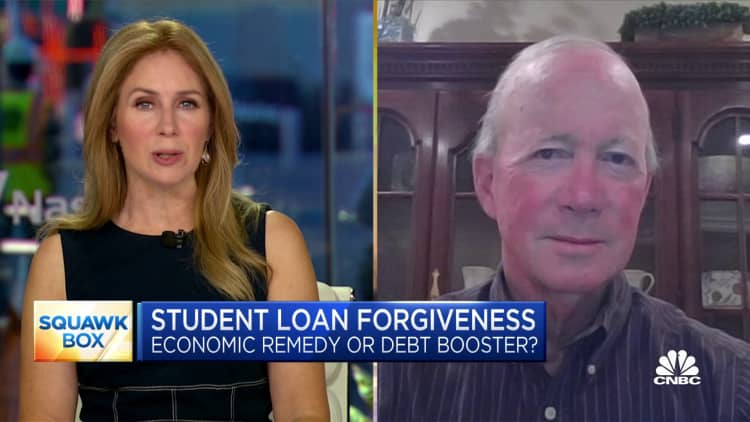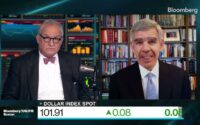Millions of student loan borrowers still aren’t making payments
Student loan forgiveness advocates rally outside the U.S. Supreme Court building in Washington, D.C., after the nation’s high court struck down President Joe Biden’s student debt relief program, June 30, 2023.
Kent Nishimura | Los Angeles Times | Getty Images
Nearly a year before federal student loan payments restarted, the U.S. Department of Education warned that many borrowers could struggle to pay their bills again.
“Unless the [Education] Department is allowed to provide debt relief, we anticipate there could be an historically large increase in the amount of federal student loan delinquency and defaults as a result of the COVID-19 pandemic,” Education Department Undersecretary James Kvaal said in a court filing.
The Supreme Court in June blocked President Joe Biden’s plan to cancel up to $20,000 in student debt per borrower — and those warnings are now becoming real. To that point: just 60% of people with federal education loans, with payments due in October, paid their bill by mid-November, U.S. Department of Education data published this month shows.
Outstanding student loan debt in the U.S. now exceeds $1.7 trillion, burdening Americans more than credit card or auto loan debt.
The average loan balance at graduation has tripled since the 1990s to $30,000 from $10,000. Additionally, some 7% of student loan borrowers are now more than $100,000 in debt.
Here’s what experts have to say about the new findings.
‘A massive student debt strike’
The fact that up to 40% of borrowers didn’t make a payment “reflects exactly what we’ve been warning would happen should Biden turn the debt collection apparatus back on,” said Astra Taylor, co-founder of the Debt Collective, a union for debtors.
“Faced with the impossible choice of feeding their kids, keeping a roof over their head or throwing an average of $400 a month into the Department of Education incinerator, borrowers are rightly choosing to keep themselves and their families financially afloat,” Taylor said.
Astra Taylor
Courtesy: Astra Taylor
“This is, in essence, a massive student debt strike,” she added.
The Debt Collective has recently created a petition in which borrowers can write to the U.S. Department of Education and request that it cancel their student debt. So far, more than 35,000 people have done so, the organization says.
‘Unfortunately unsurprising’
The repayment problems for borrowers are “unfortunately unsurprising,” said Persis Yu, deputy executive director at the Student Borrower Protection Center.
“Neither borrowers nor the student loan system were prepared to resume repayment,” Yu said.
Even before the pandemic, when the U.S. economy was in one of its healthiest periods in history, nearly half of student loan borrowers were behind on their payments or enrolled in relief measures for those struggling, including deferments or forbearances, according to an analysis by higher education expert Mark Kantrowitz.
More from Personal Finance:
IRS unveils disclosure program for businesses duped by pandemic-era tax credit
3 year-end investment tax tips from top-ranked financial advisors
IRS waives $1 billion in penalties. Who qualifies and how much taxpayers may get
Meanwhile, Yu said, “servicers are overwhelmed and are failing to help struggling borrowers navigate the options that are available to them.”
Indeed, many borrowers describe challenges trying to get current on their student loans, with long wait times trying to reach their servicers, errors with their bills, lost account information and confusion over new options rolled out over the past three years.
Carolina Rodriguez, director of the Education Debt Consumer Assistance Program, a nonprofit in New York, said she’s never seen this kind of chaos in the student loan space before.
“Servicers are having a very hard time getting people back into repayment,” Rodriguez said.
Yu pointed out that Biden’s plan to cancel student debt was designed to alleviate borrower hardship, and she blamed the legal challenges to the president’s relief and the Supreme Court’s decision for the current situation.
“What we see happening is the natural consequence of the right wing’s effort to kill debt relief,” Yu said.
‘Borrowers just not realizing payments have come due’
Meanwhile, other financial experts say the transition back to repayment after more than three years was bound to be difficult.
“I attribute some of it to some borrowers just not realizing payments have come due,” said Betsy Mayotte, president of The Institute of Student Loan Advisors, a nonprofit.
Meanwhile, others may be taking advantage of the Biden administration’s 12-month “on-ramp” to repayment, during which they’re shielded from the worst consequences of falling behind, experts say.

But Scott Buchanan, executive director of the Student Loan Servicing Alliance, a trade group for federal student loan servicers, said he is worried that some student loan holders were confusing that relief for another extension of the payment pause. (The stay on bills was extended eight times.)
“There is a fundamental difference here,” Buchanan said. “Interest is accruing now.”
Throughout the payment pause, which went into effect in March 2020, the interest rates on most federal student loans were set to zero. But interest began accruing again on Sept. 1.
As a result, borrowers who don’t make payments now will see their balances grow.
Still, Buchanan said he also wasn’t surprised by the large share of borrowers who haven’t made a payment yet. He said it was usually a trying process to get people back into repayment after long breaks from their bills.
“It will likely be early 2024 before things normalize,” Buchanan said.
Don’t miss these stories from CNBC PRO:
[ad_2]
Source link


